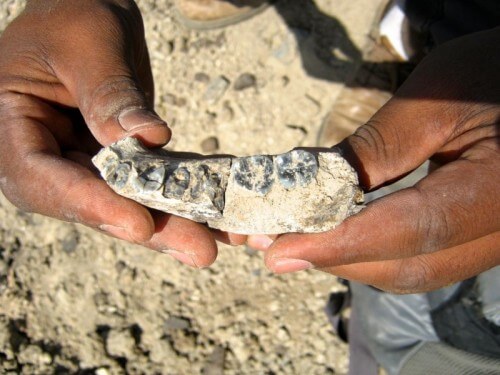This is a rare find of a fossil from the transition period between the Australopithecus lineage and the Homo lineage from which modern man is a descendant

A fossilized jawbone found at the Ladi-Garran research site in the Afar state of Ethiopia pushes back the evidence for the existence of the genus Homo as far as 2.8 million years before our time. This is according to two reports published on March 4 in the online version of the journal Science. The bone was discovered in 2013 by a team of researchers from the Universities of Arizona and Nevada.
For decades, scientists have searched for fossils from Africa documenting the first stages of the Homo lineage, and few of them have been preserved in a condition that allows them to be studied. However, the fossils recovered from this critical period between 3 and 2.5 million years before our time were frustratingly few and therefore there was very little agreement on the time and origin of the lineage that eventually gave rise to modern humans.
According to the new fossil discovered at the Ledi-Garrero site, the fossils provide clues to changes in the jaw and teeth that occurred in the genus Homo only 200 years after the last appearance of the species Australopithecus afarensis (Lucy) at the nearby site in the Ethiopian city of Hadar.
A group led by Kalachao Simim, a doctoral student at the University of Arizona, the fossil preserved the left side of the lower jaw, as well as five teeth. After analyzing the findings, advanced features were revealed, for example thin molars, symmetrical front molars and a jaw with identical proportions - something that distinguishes the early species of the genus Homo such as Homo abilis who lived 2 million years ago from the earlier species - Australopithecus. But the sloping chin links Homo Avilis to its Lucy-like predecessors. "Despite many searches, fossils of the Homo lineage over 2 million years old are very rare," says Brian Wilmuer of the University of Nevada, Las Vegas. "To get a glimpse of the first steps in the evolution of our lineage is especially exciting."
In a report in the journal Nature, Fred Spoor and his colleagues present a reconstruction of the deformed lower jaw belonging to a 1.8 million-year-old individual of the species Homo habilis ("Handy Man") from Oldubai, Tanzania.
The reconstruction presents an unexpected primitive portrait of the jaw of Homo abilis and links it to the Meldi fossil.
"Maldi's jaw will help us to shorten the evolutionary gap between Australopithecus and the first Homo," the researchers write. "This is a case of a transitional fossil from an important period in human evolution."
Climate change led to the desiccation of Africa 2.8 million years ago, and several species appeared and became extinct at the same time, including the original first homo. In an accompanying article about the geological and environmental context of the Ladi Guerrero jaw, Erin DiMaggio of the University of Pennsylvania writes that many mammal fossils were found at the site that lived at the same time as the mandible - that lived in more open environments - grassy areas and low bushes and that were different from the landscapes that were common at the sites of the last Australopithecus Such as in Hadar, where Lucy's chassis was discovered.
"However, it is difficult to know whether climate change is responsible for the appearance of the gay type. We need a larger sample of hominin fossils and that's why we keep coming to the Ledi Guerrero area to investigate.”
to the notice of the researchers
Institute of Human Origins Discovery from Arizona State University on Vimeo.

4 תגובות
Gilad - it is not contradictory; The fact that the common ancestor between us and chimpanzees lived, say, 5 million years ago, does not mean that the first creatures in the branch, immediately after the split, were already human.
According to what I remember, the time point at which a split between us and the chimpanzees (from a common ancestor) occurred 5-7 million years ago, does what is said here contradict this in any way?
good